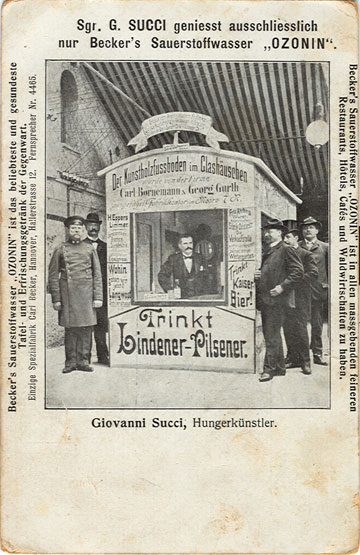Franz Kafka’s “A Hunger Artist” has always been one of my favorite short stories, but I never really looked into the history of professional fasters. These were entertainers, not political protestors, who went on long hunger strikes to amaze ticket buyers at dime museums with the art of self-abnegation. The popularity of the “sport” pretty much ended in the early twentieth century. Giovanni Succi, who was often referred to as “the little Italian” in newsprint, was one of the most celebrated practitioners.
In “Succi’s Long Fast,” a New York Times article dated November 6, 1890, the 38-year-old Succi announced his intention to starve himself for a personal record of 45 days at Koster & Bial’s music hall/beer garden in Manhattan. Succi would be on display 24 hours a day as his body wasted; student volunteers from Bellevue Medical College would be on hand to minister to his needs.
A Brooklyn Daily Eagle article from the following month picks up the story more than 40 lost pounds later. An excerpt from “Succi Breaks His Fast”:
“It was a remarkable scene, that of the last act in the long fast of Succi, which was successfully concluded at 8:10 o’clock last night. The 45 days were up at 8:10 o’clock but a photographer wanted to get a picture of Succi about to take his first meal and there was a delay of eight minutes, during which time Succi stood with a cup of cocoa in his hand and patiently submitted to the artist’s arrangements. The delay almost resulted fatally, for Succi had wanted his first meal. He was voracious. But after the aroma of the draught had floated in his face for several minutes he seemed to sicken and to suffer from nausea. He was twelve minutes drinking the single cup of cocoa, and he took it as though it was a dose of bitter medicine.”
Tags: Giovanni Succi

